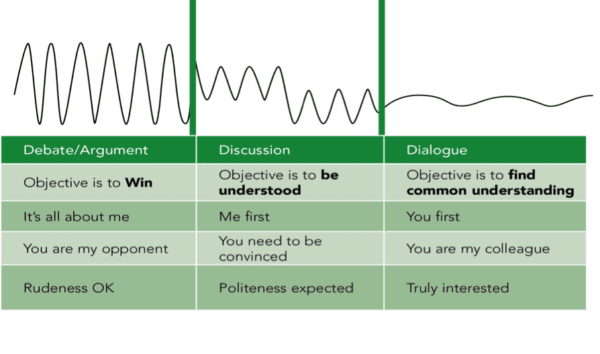 Of all of the conflict resolution activities that we have at our disposal – and there are a lot of them – this one is probably the granddaddy of them all.
Of all of the conflict resolution activities that we have at our disposal – and there are a lot of them – this one is probably the granddaddy of them all.
Do you feel like I do – not only don’t people listen, but most don’t know how to listen? There’s only one answer and they have it. They have their position. They are right and you are not. Yes, I know this is a generalization, but with the recent shootings in Baton Rouge, St. Paul, and Dallas, as well as the subsequent protests, people are shouting to be heard. Richard Nixon once said, “We cannot learn from one another until we stop shouting at one another, until we speak quietly enough so that our words can be heard as well as our voices.”
This Isn’t Debatable
Let’s have a dialogue rather than a debate. In a debate, we are trying to prove something. In a dialogue, we are trying to improve something. A debater’s objective is to win and rudeness is okay. How effective were the presidential debates in truly understanding different points of view? In a dialogue, the objective is to build understanding between and among people. It isn’t necessary to come to agreement but to suspend our assumptions and biases and to deeply listen to the other person.
Dialogue is more than a conversation. It is the ability to talk together in a way that treats people as equals and searches for shared understanding. As far as conflict resolution activities go, dialogue is rarely practiced well in private, much less in public, spaces. We all need to learn to talk to each other more effectively, rather than just try to convince each other that we are right. Think about your personal communication at these three levels.
 To make dialogue work, we need to plan ahead and create a safe place for the participants by doing the following:
To make dialogue work, we need to plan ahead and create a safe place for the participants by doing the following:
- Make openness and trust the rule rather than the exception.
- Encourage and reward the injection of new perspectives.
- Ask all to honestly inspect assumptions and biases.
- Plan the agenda to allow for in-depth interaction.
- Search for strength and value in other positions.
There are many conflict activities available and creating a dialogue is key. This type of conversation takes practice. Start now.
Author: Marty Rozelle
